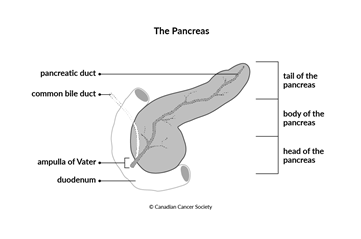The pancreas
The pancreas is a medium-sized organ shaped like a slim pear, with a wide head, long slim body and pointed tail. It is on the right side of the body, below the liver and behind the stomach and duodenum. The pancreas plays a role in digestion as a part of the digestive system, and in controlling growth and metabolism as a part of the endocrine system.
You can live without a pancreas, but there are serious long-term effects. If the pancreas needs to be removed because of disease, you will have to take several medicines for the rest of your life to replace the essential roles that the pancreas plays.
Cells of the pancreas
The pancreas is made up of exocrine cells and endocrine cells. These cells have different functions. Together they control digestion and metabolism.
Exocrine cells
About 99% of the cells in the pancreas are exocrine cells. These cells make up the part of the pancreas that is a part of the digestive system.
The pancreas has 2 types of exocrine cells.
Acinar cells form clusters around ducts in the pancreas. They make and release a variety of digestive enzymes that help to break down fats, carbohydrates and proteins in food.
Ductal cells form the epithelial cell layer that lines the inner walls of the pancreatic ducts. They make and release buffers, which are substances that counteract the acidity of partially digested food that empties from the stomach so that it doesn't damage the intestines.
Together, the enzymes and buffers form pancreatic juices. When food enters the small intestine, the pancreas releases pancreatic juices into the pancreatic ducts, which then empty into the first segment of the small intestine (the duodenum) to be used for digestion.
Endocrine cells
About 1% of the pancreas is made of endocrine cells. These cells make up the part of the pancreas that is a part of the endocrine system. Endocrine cells make and release hormones that help regulate your metabolism.
There are 4 types of endocrine cells in the pancreas:
- beta cells
- alpha cells
- delta cells
- upsilon cells
Together, they form clusters called islets (or islets of Langerhans) that surround the blood vessels in the pancreas. Each cell type releases a different hormone into the blood that plays a different role in controlling metabolism.
Insulin lowers the amount of sugar in the blood. When blood sugar levels increase, beta cells release insulin. It stimulates the liver, muscles and fatty tissues to absorb sugar from the blood and store it.
Glucagon increases the amount of sugar in the blood. When blood sugar levels decrease, alpha cells release glucagon. It stimulates the liver and other body tissues to break down sugar they have stored and release it into the blood.
Somatostatin is released by delta cells in the pancreas, but it is also made and released by other parts of the body (for example, the hypothalamus in the brain). Somatostatin plays many roles in metabolism and growth in the body, including decreasing the amount of insulin, glucagon, pancreatic enzymes and bile released.
Pancreatic polypeptide (PP) is released by upsilon cells in the pancreas. It helps to control the amount of pancreatic enzymes and bile that is released, and the amount of nutrients absorbed by the intestine.
Structure of the pancreas
The pancreas is about 15 to 25 cm (6 to 8 in) long. The widest part is called the head. The narrowest part is called the tail. The middle part is called the body.
The main pancreatic duct is a thin tube that runs almost the entire length of the pancreas. A series of smaller ducts collect pancreatic juices from exocrine cells throughout the organ. These small ducts then drain into the larger, main pancreatic duct. The pancreatic duct joins the lower part of the common bile duct to form a channel called the ampulla of Vater. This carries then empties bile (from the liver and gallbladder) and pancreatic juices (from the pancreas) into the first segment of the small intestine (duodenum) where they will help in digestion.

Your trusted source for accurate cancer information
With support from readers like you, we can continue to provide the highest quality cancer information for over 100 types of cancer.
We’re here to ensure easy access to accurate cancer information for you and the millions of people who visit this website every year. But we can’t do it alone.
Every donation helps fund reliable cancer information, compassionate support services and the most promising research. Please give today because every contribution counts. Thank you.
